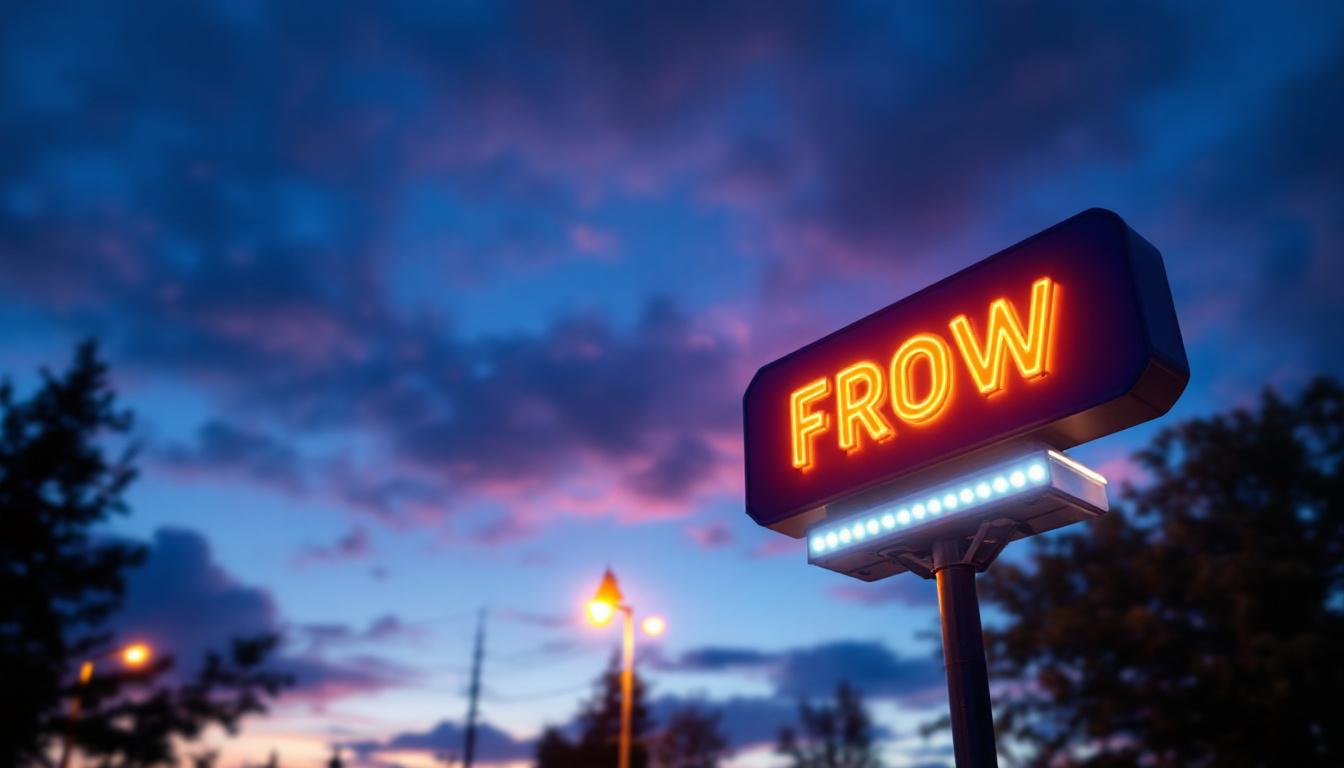
For lighting contractors, the integration of lights for signs is more than a mere accessory-it’s a pivotal element that can define the success of a project. Sign lighting not only enhances visibility but also plays a significant role in branding, safety, and energy efficiency. Understanding its impact enables contractors to deliver solutions that meet client expectations while adhering to regulatory standards.
Signage serves as a business’s first impression, especially during nighttime hours or in low-light environments. Effective illumination ensures that signs are legible and attractive, which directly influences customer engagement and foot traffic. For contractors, this means that the choice of lighting technology and installation techniques must be carefully considered to optimize both aesthetics and functionality.
Moreover, the choice of lighting can significantly affect the overall ambiance of a space. For instance, LED lights are increasingly favored due to their longevity and energy efficiency, allowing businesses to save on operational costs while maintaining a vibrant appearance. Additionally, the color temperature of the lights can evoke different emotions; warmer tones may create a welcoming atmosphere, while cooler tones can convey professionalism and modernity. This nuanced understanding of lighting can empower contractors to tailor their solutions to the specific branding needs of their clients, ensuring that the sign not only stands out but also aligns with the overall message of the business.
Furthermore, the integration of smart lighting technology is revolutionizing the way sign lighting is approached. With advancements in automation and control systems, contractors can now offer dynamic lighting solutions that adjust based on environmental conditions or time of day. This not only enhances visibility but also contributes to energy conservation efforts, as lights can be dimmed or brightened automatically. Such innovative approaches not only meet the practical needs of businesses but also position contractors as forward-thinking leaders in the industry, capable of delivering cutting-edge solutions that enhance both functionality and sustainability.
LED (Light Emitting Diode) technology has become the dominant choice for sign illumination due to its energy efficiency, longevity, and versatility. LEDs consume significantly less power compared to traditional incandescent or neon lights, which translates to lower operating costs for clients. Additionally, LEDs offer a wide range of color options and brightness levels, allowing for customized lighting solutions that enhance brand identity.
From channel letters to backlit signs, LEDs can be adapted to various formats. Their compact size and durability make them ideal for both indoor and outdoor applications, and their low heat emission reduces the risk of damage to sign materials. Moreover, the technology behind LEDs continues to evolve, with advancements in smart lighting systems that allow for dynamic color changes and programmable effects. This capability not only attracts attention but also enables businesses to promote seasonal campaigns or special events with ease, making LED signage a powerful marketing tool.
While LEDs dominate the market, neon and fluorescent lights still have their place, especially in projects requiring a vintage or artistic aesthetic. Neon lighting is prized for its vibrant glow and ability to create unique shapes and colors. However, it is less energy-efficient and requires more maintenance than LED alternatives. The craftsmanship involved in creating custom neon signs adds to their allure, as each piece is hand-bent to achieve the desired design, resulting in a one-of-a-kind product that can become a focal point in any space.
Fluorescent lighting, on the other hand, is commonly used in larger signs and can provide uniform illumination. However, it is less durable and has a shorter lifespan, which contractors must consider when advising clients on long-term costs and maintenance. Despite these drawbacks, fluorescent lights are often favored in commercial settings where bright, even lighting is essential, such as in retail environments or restaurants. Their ability to illuminate large areas effectively can enhance visibility and attract customers, making them a practical choice for businesses looking to maximize their signage impact.
Lighting contractors today face increasing pressure to incorporate sustainable practices into their projects. Sign lighting, if not thoughtfully designed, can contribute to excessive energy consumption and light pollution. LEDs offer a compelling solution by significantly reducing energy usage and carbon footprint. The shift towards LED technology not only enhances energy efficiency but also provides a longer lifespan compared to traditional lighting options, which means fewer replacements and less waste in landfills. This longevity is particularly beneficial for businesses looking to minimize maintenance costs and reduce their environmental impact.
Moreover, many clients are now seeking lighting solutions that comply with green building certifications and local environmental regulations. Contractors who are knowledgeable about energy-efficient technologies and can demonstrate measurable savings are better positioned to win contracts and build lasting client relationships. As awareness of climate change and sustainability grows, businesses are increasingly prioritizing eco-friendly practices, making it essential for contractors to stay informed about the latest trends and innovations in sustainable lighting solutions.
Integrating smart controls such as dimmers, timers, and motion sensors can further enhance the efficiency of sign lighting. These systems allow signs to operate only when necessary, reducing waste and extending the lifespan of lighting components. For example, signs can be programmed to dim during late-night hours or turn off automatically during daylight, aligning with business hours and local ordinances. Additionally, advanced smart lighting systems can be integrated with building management systems, allowing for centralized control and monitoring, which can lead to even greater energy savings and operational efficiency.
Furthermore, the use of smart lighting can provide valuable data insights into usage patterns and energy consumption, enabling contractors and clients to make informed decisions about future upgrades and maintenance. By analyzing this data, businesses can identify peak usage times and adjust their lighting strategies accordingly, ensuring that they are not only compliant with regulations but also maximizing their return on investment. This level of automation not only enhances the functionality of sign lighting but also contributes to a more sustainable urban environment by minimizing light pollution and energy waste, ultimately benefiting both businesses and the communities they serve.
Proper installation begins with a thorough site assessment. Lighting contractors must evaluate factors such as power availability, mounting surfaces, weather exposure, and local codes. This ensures that the lighting system is both safe and effective.
Electrical load calculations are critical to prevent overloads and ensure compliance with electrical codes. Contractors should also consider surge protection and waterproofing to safeguard the lighting system from environmental damage.
Designing for ease of maintenance is another key consideration. Lighting contractors should plan installations that allow for quick access to bulbs, drivers, and wiring. This reduces downtime and service costs for clients, enhancing overall satisfaction.
Regular maintenance schedules, including cleaning and inspections, help maintain optimal brightness and prevent premature failures. Contractors can offer maintenance contracts as an additional service, providing ongoing value to clients.
Compliance with local, state, and national regulations is non-negotiable in sign lighting projects. This includes adherence to electrical codes, zoning laws, and lighting ordinances that govern brightness levels and light trespass.
Lighting contractors must stay updated on these regulations to avoid costly fines and project delays. For example, some municipalities restrict the use of certain colors or flashing lights to prevent distractions for drivers. Understanding these nuances enables contractors to design compliant and effective signage lighting.
Excessive or poorly directed sign lighting can contribute to light pollution, affecting nearby residents and wildlife. Contractors should employ techniques such as shielding, directional lighting, and appropriate brightness levels to minimize these impacts. This not only aligns with environmental responsibility but also fosters positive community relations for clients.
Advancements in LED technology have paved the way for dynamic and interactive signs that can change colors, display animations, or respond to environmental cues. These innovations offer exciting opportunities for lighting contractors to expand their service offerings and deliver cutting-edge solutions.
For instance, programmable LED signs can be updated remotely, reducing the need for physical maintenance and allowing clients to adapt their messaging in real-time. This flexibility is highly valued in retail, hospitality, and entertainment sectors.
Another growing trend is the integration of sign lighting with renewable energy systems such as solar panels. This approach can significantly reduce operational costs and environmental impact, appealing to eco-conscious clients and municipalities.
Lighting contractors who develop expertise in renewable energy integration can differentiate themselves in a competitive market and contribute to sustainable urban development.
For lighting contractors, mastering the complexities of sign lighting is essential to delivering projects that meet both functional and aesthetic goals. By leveraging energy-efficient technologies, adhering to regulatory standards, and embracing innovative trends, contractors can enhance their reputation and provide exceptional value to clients.
Successful sign lighting projects not only illuminate businesses but also contribute to safer, more vibrant communities. As the demand for visually striking and sustainable signage continues to grow, lighting contractors who stay informed and adaptable will be well-positioned to lead in this evolving field.
Ready to elevate your sign lighting projects with the highest quality solutions at the best value? Look no further than LumenWholesale. Our spec-grade lighting products are designed to meet the needs of the most discerning lighting contractors. With unbeatable wholesale prices and free shipping on bulk orders, you can trust us to provide the performance and savings you require. Don’t let middleman markups dim your project’s potential. Choose LumenWholesale for a seamless blend of quality, affordability, and convenience. Wholesale Lighting at the Best Value is just a click away. Enhance your sign lighting expertise with us today!

Discover the essential insights every lighting contractor needs about fluorescent light bulbs.

Discover the top strategies lighting contractors use to optimize automatic timers for lights.

Explore the science of ceiling lamps with insights tailored for lighting contractors.

Illuminate your outdoor spaces with expert insights! Discover essential tips and innovative strategies for lighting contractors to enhance yard aesthetics and functionality with the perfect light posts..